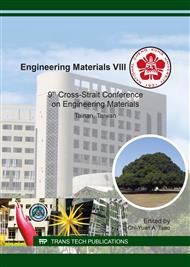p.1
p.5
p.11
p.16
p.24
p.32
p.38
p.43
p.50
Effect of Heat Treatment on Microstructures and Mechanical Properties of Al-Modified Boron High Speed Steel
Abstract:
Boron-bearing high speed steels are widely used in roller materials because of their improved wear resistance and toughness. In present work, aluminum was added into boron high speed steel and the aging-hardening behavior and microstructures of tempered boron high speed steel at various tempering temperatures were investigated by means of scanning electron microscopy (SEM), X-ray diffraction (XRD), Energy dispersive spectrometry (EDS) and HR-150A Rockwell hardness tester. The results show that the bulk hardness of boron high speed steel gradually enhances with the increasing destabilized temperature. Aluminum addition cuts down the bulk hardness and delays the hardening process, thus leading to high the hardening value of boron high speed steel shifting to higher destabilized temperature. After tempering process, boron-bearing high speed steel displays precipitate-hardening behavior at the tempered temperature of about 520°C. The bulk hardness of boron-bearing high speed steel achieves 60.5 HRC as a maximum value when the aluminum addition is 0.6 wt.%. More aluminum addition can result in lower precipitate-hardening rate and bulk hardness. The microstructures of boron high speed steel tempered at 520°C consist of eutectic borides and tempered martensite dispersed a lot of secondary precipitates. XRD and TEM results indicate that the precipitate-hardening properties of boron high speed steel depend on precipitates and square degree of martensite
Info:
Periodical:
Pages:
24-31
Citation:
Online since:
March 2017
Authors:
Price:
Сopyright:
© 2017 Trans Tech Publications Ltd. All Rights Reserved
Share:
Citation:


